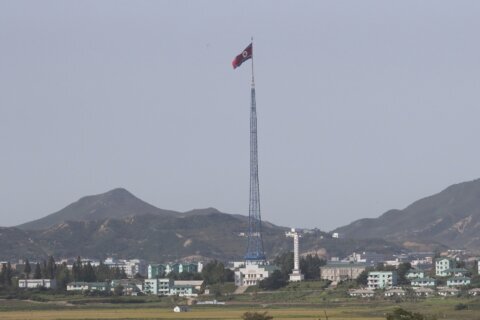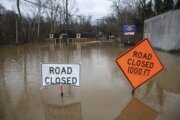WASHINGTON (AP) — A record 23 of NATO’s 32 member nations are hitting the Western military alliance’s defense spending target this year, NATO Secretary-General Jens Stoltenberg said Monday, as Russia’s war in Ukraine has raised the threat of expanding conflict in Europe.
The estimated figure is a nearly fourfold increase from 2021, when only six nations were meeting the goal. That was before Russian President Vladimir Putin’s full-scale invasion of Ukraine in 2022.
“Europeans are doing more for their collective security than just a few years ago,” Stoltenberg said in a speech at the Wilson Center research group.
After the speech, Stoltenberg met at the White House with President Joe Biden. The U.S. president said the alliance has become “larger, stronger and more united than it’s ever been” during Stoltenberg’s tenure.
Biden spoke affectionately of Stoltenberg, calling him “pal” and saying he wished that Stoltenberg, who has been NATO’s secretary general since 2014, could serve another term when the current one expires in October.
“Together, we’ve deterred further Russian aggression in Europe,” Biden said. “We’ve strengthened NATO’s eastern flank ,making it clear that we’ll defend every single inch of NATO territory.”
Stoltenberg noted that allies were buying more military equipment from the U.S. “So NATO is good for U.S. security, but NATO is also good for U.S. jobs.” he said.
NATO members agreed last year to spend at least 2% of their gross domestic product on defense. The surge in spending reflects the worries about the war in Ukraine.
Poland, at more than 4%, and tiny Estonia both lead the United States this year in the percentage of their GDP they spend on defense. Both countries border Russia.
Defense spending across European allies and Canada was up nearly 18% this year alone, the biggest increase in decades, according to NATO’s estimated figures released Monday.
Some countries also are concerned about the possible reelection of former President Donald Trump, who has characterized many NATO allies as freeloading on U.S. military spending and said on the campaign trail that he would not defend NATO members that don’t meet defense spending targets.
“Shifting U.S. administrations have had the absolutely valid point to say that U.S. allies are spending too little,” Stoltenberg told reporters. “The good news is that’s changing.”
Stoltenberg’s visit is laying the groundwork for what’s expected to be a pivotal summit of NATO leaders in Washington next month. The mutual-defense alliance has grown in strength and size since Russia’s invasion of Ukraine two years ago, with both Sweden and Finland joining.
Defense spending by many European countries fell after the 1991 collapse of the Soviet Union seemed to neutralize what was then the prime security threat to the West.
But after Russia seized Ukraine’s Crimean Peninsula in 2014, NATO members unanimously agreed to spend at least 2% of their GDP on defense within a decade. The full-scale invasion that Putin launched in 2022 spurred European countries newly on the front line of a war in the heart of Europe to put more resources into meeting that target.
Much of the focus of the summit is expected to address what NATO and NATO member governments can do for Ukraine as it faces unrelenting air and ground attacks from its more powerful neighbor. They so far have resisted Ukrainian President Volodymyr Zelenskyy’s appeals to take his country into the bloc as long as the war is still on.
Stoltenberg pointed to efforts to bolster Ukraine in the meantime. That includes NATO streamlining the eventual membership process for Ukraine, and individual NATO nations providing updated arms and training to Ukraine’s military, including the U.S. giving it F-16s and bringing Ukrainian pilots to the U.S. for training on the advanced aircraft.
“The idea is to move them so close to membership that when the time comes, when there is consensus, they can become a member straight away,” Stoltenberg said.
However Russia’s offensive concludes, only taking Ukraine into the alliance will dissuade Putin from trying again in the future to conquer Ukraine, the NATO chief said.
“When the fighting ends, NATO membership” for Ukraine “assures that the war really ends,” he said.
The prospect of Ukraine joining NATO has long been anathema to Putin, and it was one of his stated motivations for seizing Crimea. He offered last week to order an immediate cease-fire if Ukraine renounced plans to join the alliance, an offer that was dismissed by Ukraine.
A weekend conference held in Switzerland was billed as a first step toward peace and ended with pledges to work toward a resolution but had few concrete deliverables. It was attended largely by Western nations and Russia was not invited. China sat it out and then India, Saudi Arabia, South Africa and Mexico did not sign the meeting’s final document Sunday.
Kyiv’s outgunned and outnumbered forces are battling to hold back the bigger Russian army, which has taken over chunks of territory after pollical squabbles led to delays in delivering U.S. and European military aid. Ukraine has been short of troops, ammunition and air defenses in recent months as the Kremlin’s forces try to cripple the national power supply and punch through the front line in eastern parts of the country.
Copyright © 2024 The Associated Press. All rights reserved. This material may not be published, broadcast, written or redistributed.






